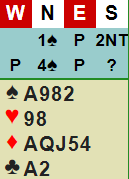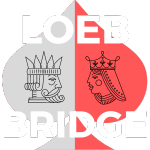Jacoby 2NT: "The Good, the Bad, the Ugly, and the Fix"
 When your partner opens 1-of-a-major and you have a game forcing hand with 4+ card support, you don’t want to jump to 4-of-the-major. Partner may have a good hand. A slam may be available. To leave room to find slams, it is common to use a jump to 2NT as an artificial game forcing raise, showing 4+ card support and 13+ points. This agreement is called Jacoby 2NT.
When your partner opens 1-of-a-major and you have a game forcing hand with 4+ card support, you don’t want to jump to 4-of-the-major. Partner may have a good hand. A slam may be available. To leave room to find slams, it is common to use a jump to 2NT as an artificial game forcing raise, showing 4+ card support and 13+ points. This agreement is called Jacoby 2NT.
|
North |
East |
South |
West |
|
1♠ |
Pass |
2NT* |
Pass |
|
? |
|
|
|
The traditional responses to a Jacoby 2NT game forcing major suit raise are:
| Opener's Rebid | Description |
|
3♣, 3♦, 3-of-other-major |
Singleton or void, doesn’t show or deny extra values |
| 3-of-major | Non-minimum, no shortness |
| 3NT | Varying agreements, typically balanced 18-19 HCP |
| 4♣, 4♦, 4-of-other-major | 5+ card suit headed by 2 of the top 3 honors |
| 4-of-major | Minimum opener |
The Jacoby 2NT game forcing raise is typically off in competition, and off by a passed hand. After an overcall, it is common to use a cue bid to show an invitational or better raise. Over a takeout double, partnerships playing Jordan will use 2NT as a conventional raise showing invitational or better values. Passed hands would be well advised to use some form of Drury to show an invitational raise.
Handling Interference:
It is always nice when the opponents remain silent while you and your partner assess slam chances. Some of your opponents may not be so cooperative. A lead directing overcall can pay big dividends. Sometimes the opponents will preempt your Jacoby 2NT auctions. Billy Miller shares advice on handling Jacoby 2NT interference in his "The Coolest Gizmos and Gadgets" column. Billy recommends a structure enabling a partnership to quickly determine if they have two quick losers in the opponent's suit.
Evaluating the Strengths & Weaknesses of the Traditional Jacoby 2NT
The Good: Using a 2NT response as a game forcing raise leaves room to look for slams.
The Bad: The jump to 4-of-a-major to show a minimum squanders bidding space, leaving a strong responder guessing whether they should look for slams. Slams often depend on the location of honors. Forcing your partner to guess at the 5-level risks missing good slams, and risks getting too high when opener doesn’t have the right honors. For example, what should South bid on the Jacoby 2NT auction to the right?
For example, what should South bid on the Jacoby 2NT auction to the right?
If North has ♠K7654 ♥J6 ♦K7 ♣KQJ3, 5♠ may go down.
If North has ♠KQ654 ♥A6 ♦K7 ♣J983, 12 tricks are available.
The jump to 4♠ to show a minimum opener forces responder to guess at the 5-level.
If responder had room, it would be easy to use Control Bids to learn whether opener has a heart control. The partnership could stop at 4♠ if opener doesn’t have a heart control, and could reach 6♠ if opener has the right honors.
The Ugly: The shortness showing 3-level responses provide useful information for the defense. If opener has a minimum hand and responder has no slam interest, describing opener’s distribution is helpful only to the defenders. The Control showing bids after a opener’s shortness showing bid exacerbate the problem.
The Bottom Line: Jacoby 2NT is a slam finding agreement which isn’t good at finding slams and often needlessly helps your opponents find the right defense.
Fixing Jacoby 2NT
The simplest fix to Jacoby 2NT is to use opener’s 3♣ rebid to show a minimum opener. This eliminates the space stealing jump to 4-of-a-major. All responses other than 3♣ show extra values. The jump to 4♣ can be used to show extra values with club shortness.
| Opener's Rebid | Description |
|
3♣ |
Artificial, minimum opener |
| 3♦, 3-of-other-major, 4♣ | Singleton or void, extra values |
| 3-of-major | Extra values, no shortness |
| 3NT | Balanced 18-19 HCP |
| 4♦, 4-of-other-major | 5+ card suit headed by 2 of the top 3 honors, extra values |
| 4-of-major | -- Not allowed -- Fast Arrival doesn't apply opposite an unlimited hand |
These responses make it easy for opener to describe their shape and show extra values. The responses leave the room needed to look for slam.
After Opener Shows a Minimum
After opener shows a minimum, responder will typically place the contract at game, and the defenders will not know if opener has shortness, or about any controls in a side-suit.
If responder has slam interest opposite a minimum opener, responder can make a slam try by making a Control Bid. If responder has all suits controlled and only needs to learn about Key Cards, they can jump to 4NT, Roman Key Card Blackwood.
Sometimes a slam depends on shortness covering your losers. If shortness in the right suit can allow a slam to be made opposite a minimum opener, responder bids 3 to ask for shortness. The easiest way for opener to show shortness is to bid their short suit.
|
North |
East |
South |
West |
|
1♠ |
Pass |
2NT* |
Pass |
|
3♣* |
Pass |
3♦* |
Pass |
| ? |
- Bidding a new suit shows a singleton or void
- Bidding the agreed major denies a singleton or void
Partnerships with good memories may prefer to use steps to show shortness because it is more space efficient. With that agreement:
| Opener's Rebid | Description |
|
3♥ (1st step) |
Singleton or void in clubs (the lowest side suit) |
| 3♠ (2nd step) | Singleton or void in diamonds (the middle side suit) |
| 3NT (3rd step) | Singleton or void in the other-major (the highest side suit) |
| 3NT | Balanced 18-19 HCP |
| 4 of a new suit | Control bid, no shortness |
| 4-of-major | No shortness, no 1st or 2nd round controls in a side suit which can be shown below game |
Related Articles
The Traditional Jacoby 2NT Structure: See Karen Walker’s “Jacoby 2NT -- Forcing Major-Suit Raise” article for a good discussion of the traditional continuations after a Jacoby 2NT game forcing raise.
Epert partnerships with good memories should consider using a more advanced structure.
- Our expert version of Jacoby 2NT includes invitational hands in the Jacoby 2NT response. Since responder isn't guaranteeing game forcing values, it is riskier for the opponents to sacrificie or make a lead directing overcall. This frees up a response of 3M to show a Mixed Raise. The structure gives responder a way to show a a hand too strong for an immediate Splinter Bid.
- In his "Limited Bidding: Reengineering Jacoby 2NT" article, Andrew Gumperz recommends using an artificial 3♣ bid to show a minimum opener. If opener shows a minimum hand, responder can ask about opener’s shape if interested in slam. Otherwise responder places the contract at game, hiding opener’s distribution. An immediate 3♦ or 3♥ response by opener shows extra values and unspecified shortness. 3♦ shows an unspecified singleton. 3♥ shows an unspecified void. Responder can then ask the location of opener’s shortness. Later in the article, Andrew provides an optional recommendation to include 4-card invitational raises in the Jacoby 2NT response. This has the advantage of allowing a 1M-3M to be used as a preemptive raise or a mixed raise. Including invitational raises in the Jacoby 2NT makes it more risky for the opponents to interfere in your Jacoby 2NT auctions.
- Those willing to take on a bit more complexity can benefit from Larry Cohen’s "Modified Jacoby 2NT (for Advanced-Expert Level)" article. Cohen’s structure uses an artificial 3♣ response to show a minimum opener. So opener’s distribution is hidden when not in the slam zone; and the preemptive 4M Fast Arrival rebid is avoided. The structure allows opener to show hands with singletons, hands with voids, balanced hands, and semi-balanced hands.
- As Andrew Gumperz describes in his “Evaluating for Slam 5: Jacoby 2NT Auctions” article, fitting doubletons in opener’s hand can make slam possible with fewer HCP. So Cohen’s structure to locate opener’s doubletons when opener holds a semi-balanced hand (i.e. 5-4-2-2, 6-3-2-2, 7-3-2-2), position responder to use the partnership’s the Short Suit Total to assess slam chances.
- In his “Wilson 2NT” article, Kevin Wilson recommends including 4-card invitational raises and powerful Splinter bids into the 2NT game forcing response. Kevin’s structure is similar in many ways to Larry Cohen’s recommendations, but adds provisions for the invitational raises and big Splinter hands.
- See Andrew Gumperz's "Evaluating for Slam 6--More Tips about Jacoby 2NT" article for tips on slam bidding after a Jacoby 2NT game forcing raise.
When you have a 9-card or better major suit fit, it is rarely right to play 3NT. So many expert partnerships have applied a conventional meaning to a 3NT bid in a Jacoby 2NT auction. The 3NT bid is typically used as a switch to show (or deny) extra values in the context of the previous bidding. Using the 3NT bid as a non-serious slam try, showing willingness to cooperate if partner is interested in slam, makes it easy to differentiate a hand with strong slam interest from a hand which is willing to cooperate with a slam try (the Serious 3NT convention provides the same benefit but uses an artificial 3NT bid to show strong slam interest). If playing the traditional version of Jacoby 2NT, it is vital to play Serious 3NT (or Non-Serious 3NT) is essential. When the auction begins 1M-2NT-3m, opener has shows a 5-card major and shortness in a minor and responder has shown a game forcing raise. Both hands are unlimited, but neither has guaranteed extra values. To aid slam bidding, it is vital to have a way to show (or deny) serious slam interest.




